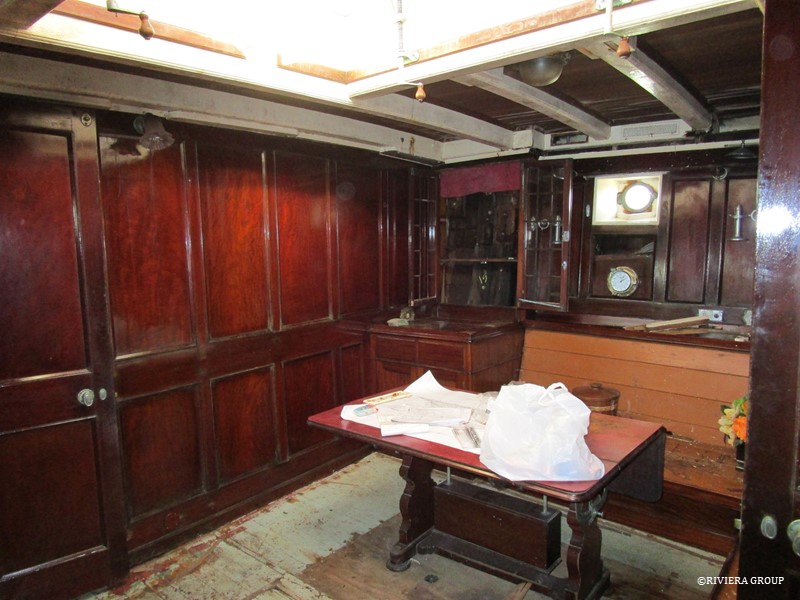November, December, 2016
In 2016, the ketch Cynara had reached the remarkable age of 89. Although she had a number of refits, fixes and “upgrades” over the years, she was definitely showing it. Though she was still afloat, she hadn’t sailed in some years.
Noboru Watanabe, CEO of the Riviera Group, asked the shipwrights Paul Harvey and Ben Hobbs, who were based in Mallorca, to inspect her inside and out, and put together a project plan for her restoration. If accepted, the restoration work would take place at Riviera’s Seabornia Marina on the coast of the Miura Peninsula, a short distance south of Tokyo.

From her bowsprit to her battered stern (below) the years had taken their toll.


A close look at the keel showed a distinct hog (above), meaning the fore and aft sections had begun to sag and the keel was no longer straight. The deckhouse (though) was in comparatively good shape, though plans showed that various changes had been made over the years, such as the addition of three portholes at the front.


The skylights on either side and the storage box were not on the original plans (an ice box went where the storage box is). These were added at a later date, possibly the 1950s, during a refit by Camper and Nicholsons, the shipyard that built her in 1927.

The teak at the stern was cracked and the cleats were lusterless. It was quite obvious that the rigging hadn’t been used for a long time.

The binnacle had clearly seen better days.

The masts and spars, too, had survived, but barely. A pronounced asymmetry was obvious with even a cursory glance (above), and the main boom end (below) had some serious rot issues.


The topmast had a large section that had rotted away that had been covered by a brass plate.

At some point in time, Cynara’s original hawse pipes had been replaced with bow rollers, probably in the 1960s. Replacing the hawse pipes, which may have corroded, would have been a difficult and expensive job, and the rollers were a quick and less expensive solution.
The interior had also suffered, but a close look revealed the potential of this project. There was much of value here. Despite the obvious issues—the grime and dust and battle scars—the interior was remarkably original and the furniture was in reasonable shape for its age.

Not much was salvageable from the crew’s cabin, though, which was a shambles. It was hard to imagine that this had once been in good enough condition to house the crew for weeks on end, as Cynara made her way from England across the Atlantic and the Pacific to Japan in 1972.

The galley looked great—state of the art, if you like the idea of being stuck in a 1950s family television sit-com.

The saloon’s once-classic appearance and the beauty of the original mahogany used in most of the interior was faintly visible behind the grime and dust and surface damage. The beautiful detail of the light fixtures (below) could also be seen if one could imagine them restored and polished to their former brilliance, and fitted with a proper lampshade.


Pity the captain who would be expected to bunk here.

The owner’s cabin had artwork on the walls (above) and a gold-painted mirror over the sink.


The heads, needless to say, were going to take some work.

The artwork over the bunk in the starboard aft guest cabin for two was pretty much the only thing in decent shape. There had been a lot of fresh water damage.

The graceful curves in the handrails of the stairway up to the deckhouse were elegant and clearly original. Each of the aft guest cabins had their own sink.

The Yanmar diesel engine in the engine room was of fairly recent lineage, but it would need to be sent out for an overhaul.
So that’s a quick tour of Cynara, above and below deck in December, 2016. While there was lots of potential, it was obvious that she would have to be dismantled and every piece looked at closely before decisions could be made on what was restorable and what was not. Mr. Watanabe asked the two British shipwrights, Paul and Ben, for a plan, with hopes that work could start as soon as possible the next year.

